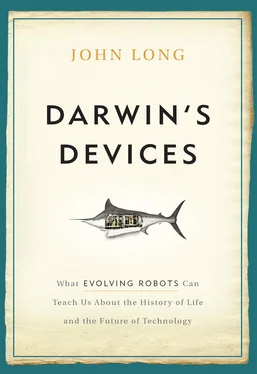To Mom, Dad, Ann, Sam, Marian, Tamasin, and Madeleine
DARWIN’S DEVICES: What EVOLVING ROBOTS Can Teach Us About the History of Life and the Future of Technology
I AM A BIOLOGIST, AND I STUDY ROBOTS. BUT AS SOON AS I started describing my research to other people, it was clear I was in trouble. I was speaking to a longtime friend and colleague about a biology grant I’d just gotten from the National Science Foundation to build robots when he stopped me in my tracks. “What do robots have to do with biology?” he asked. I knew then, with the certainty that only dread can provide, that this was an inescapable question—it was the issue that would come up first from now on, every time one of my students or I presented our strange new work to biologists.
What’s the problem? First and foremost, biologists do not study robots. They work on organisms—living things, their environments, and their evolutionary history. They use machines as tools to ascend a rainforest canopy, as instruments to measure biomechanical properties, as modes of transportation to collect fish from a coral reef. As my friend had stated so succinctly, machines in general, and robots in particular, have nothing to do with biology—from his point of view. Not from mine.
I tried to fight back, blurting out the well-rehearsed line that I’d included in the grant proposal: “We use robots to model extinct vertebrates.” With that being not so much an answer as a statement of intent, I got a raised right eyebrow and then a gentle “Well, I hope it works out for you.” Communication over and out.
I needed a better answer.
No matter how cool robots are (to me), their swaggering presence wasn’t enough to justify their usefulness in biology. And this was a problem not only for me—at least I had a grant—but also for the undergraduate researchers in my lab, who would rather avoid being recognized as having been trained by a known kook. So we talked it over until we hit upon a solution that has proven to work for about half the biologists we encounter.
We decided to equate different models of biological systems: those run on computers and those run on robots. Both are machines, after all, and computers are already used in almost every branch of biology, modeling—among myriad other things—neural networks, predator-prey interactions, virus evolution, and perambulating Tyrannosauruses . In fact, “computational biology” is the hot field right now, the bull’s eye on the what-to-be-working-on-if-you-want-a-job-in-academia dartboard.
Robots—mobile ones, anyway—are essentially self-propelled computers. They are machines that run sets of instructions—their software—and produce an output. Certainly, the outputs seem different. Computers output binary bits that we use to represent numbers, and those numbers, in turn, represent everything from screen colors to mathematical formulae to electronic books. Robots output what we recognize as behavior, but underlying it all are the same bits.
That’s not to say there might not be important distinctions between a robot and a computer. Jeff Staten, a senior engineer at IBM, says a robot “is a computer that’s inside out.” Jeff’s point is that computers today are networked and make decisions based on input from other computers most of the time and humans tapping at a keyboard only some of the time. A robot, although it has a computer inside, makes decisions on its own, with information gathered only through its sensors. The messages the robot receives and sends are physical. The mobile robot, unlike most computers, can be autonomous. What autonomous robots have, which computers don’t, is agency.
Agency is what human observers ascribe to anything, organic or artificial, that appears from an external perspective to act on its own. For those of us working in the world of artificial intelligence and cognitive science, an agent can be an organism or a machine. Humans are agents. My dog, Kooka, is an agent. And so long as there is no unseen human pulling the strings of remote control, robots are agents too.
An autonomous robot is an agent using its own sensory inputs to perceive the world, make decisions about how to move, and, in turn, having those movements affect how it perceives the world. This constant feedback between what an agent perceives and how it moves is what my colleague Ken Livingston and I call a perception-action feedback loop. Multiple perception-action loops in an agent can be operating in parallel, working in combination, fusion, or competition. What we observe the agent doing—moving and interacting with its immediate environment—is what we define as behavior.
An agent’s behavior is its computational output. “Behavior emerges from the agent-environment interaction,” as Livingston is wont to say. And behavior, by this definition, is something that autonomous robots have that computers do not. Oops. Have we just defined ourselves into an identity error that invalidates the logic of our first response? No and yes. No, because autonomous robots have, as part of their agency, embedded computers. Yes, because robots are more than simply computers that move.
Autonomous agency is, ultimately, the answer to my colleague’s question, what do robots have to do with biology? They enable us to build models of how organisms behave. Of course, building models raises another question.
It turns out that, much like most biologists think they shouldn’t be studying machines, many think they shouldn’t be studying models, either. One criticism of models or simulations of any kind, instantiated on either a computer or a robot, is that they are, at best, artificial systems that merely copycat the outward behavior of the biological system. Models, the argument goes, fail as true or accurate representations of the underlying causal phenomena because the underlying functional mechanisms are different from those operating in the system of interest. As Norbert Weiner, the founder of the field of cybernetics, is alleged to have said, “The best model of a cat is a cat.” Although this is not quite like saying that to understand cats, you can only study cats, some people do jump to that conclusion.
With this cats-only criticism in mind, my colleagues and I jump to a different conclusion about models: you have to be very careful when you build them. You have to take care to explain what you are trying to do, how you intend to do it, and how you are discriminating between a bad model and a good one. Bad models won’t be anything like cats, and therefore, they will perhaps tell you something about your ability to make a noncat—but little else. Good models, argues Barbara Webb, a biologist at the University of Edinburgh and one of the founders of the field of biorobotics, are those with explicitly defined goals and goals that are attained. Some models are meant to behave like the targeted system. In those cases a close or perfect behavioral match between your robot and its biological target—if it walks like a cat and meows like a cat—means that you have a good model.
As a real example, Sarah Partan, an animal behaviorist at Hampshire College, wanted to study how squirrels respond to the behavior of other squirrels, so she built a robot squirrel that flicks its tail and adjusts its posture. For Partan, a good squirrel model is able to trick the real squirrels into responding to the robot as if the robot were a squirrel. Happily for Partan, the trick worked.
Behaviorally speaking, Partan’s robotic squirrel is a good model of body posture and tail motion. At the same time, it is obviously a bad model of the neuromuscular mechanisms involved in limb motion. However, to model neuromuscular mechanisms wasn’t her intent. If it was, you’d judge the goodness of her neuromuscular mechanisms model not by how well it elicits tail flicks in other squirrels but rather by how closely it matches the underlying functional mechanisms used in muscles and nerves. If the artificial muscles worked like biological ones, generating peak force at only one length and for short periods of time, then she’d have modeled that mechanism accurately, irrespective of whether or not her robotic squirrel can dupe real squirrels.
Читать дальше












